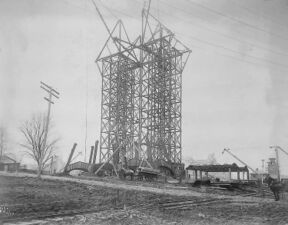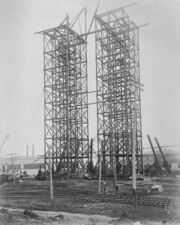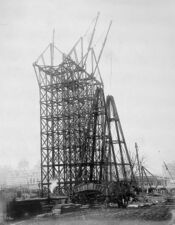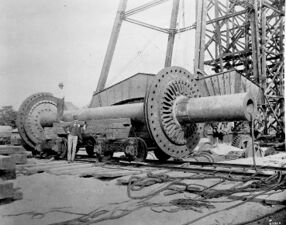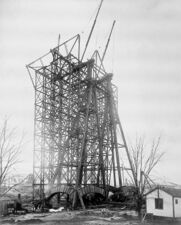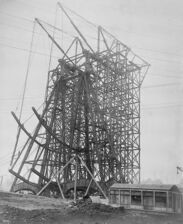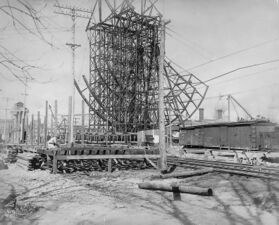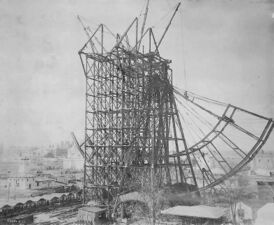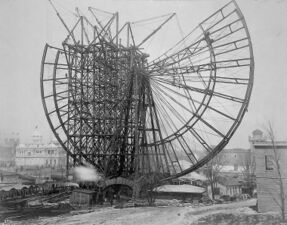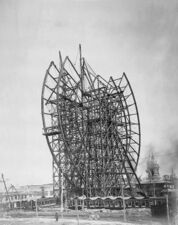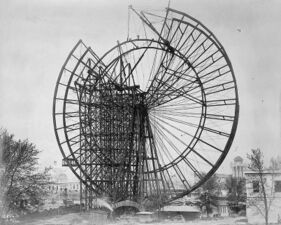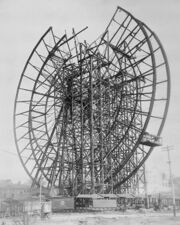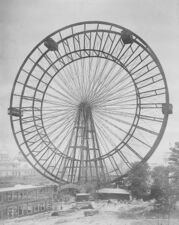Ferris Wheel: Difference between revisions
No edit summary |
No edit summary |
||
| Line 12: | Line 12: | ||
| furnishing_cost = | | furnishing_cost = | ||
| profit = $267,000 (${{Format price|{{Inflation|US|267,000|1904}}}} in {{Inflation/year|US}}) | | profit = $267,000 (${{Format price|{{Inflation|US|267,000|1904}}}} in {{Inflation/year|US}}) | ||
| owner = | | owner = Chicago House Wrecking Company | ||
| architect = | | architect = George Washington Gale Ferris Jr. | ||
| dimensions = | | dimensions = | ||
| adult_entry = 50¢ (${{Inflation|US|.5|1904}} in {{Inflation/year|US}}) | | adult_entry = 50¢ (${{Inflation|US|.5|1904}} in {{Inflation/year|US}}) | ||
| Line 26: | Line 26: | ||
==Before the Fair== | ==Before the Fair== | ||
===George Ferris=== | |||
Born in Galesburg, Illinois in 1859, Ferris attended Rensselaer Polytechnical Institute in New York, where he graduated in 1881 with a degree in engineering. | |||
Ferris claimed that he developed he concept for the Ferris wheel while at a dinner in Chicago. | |||
Ferris' one-of-a-kind design was able to carry five times the 1,200 ton capacity limit. In 80 miles an hour winds, the sway of the colossal wheel was less than half an inch. | |||
Ferris thought the 1893 fair management had robbed him and his investors of his cut in the $726,805 (${{Format price|{{Inflation|US|726,805|1904}}}} in {{Inflation/year|US}}) profit that his wheel had brought in. | |||
Constantly in litigation, Ferris continued to create smaller wheels, selling them mostly to amusement parks across the U.S., but he made little profit. Ferris desired to build and sell bigger and better wheels, but demand was sporadic. | |||
After his wife left him in 1896, Ferris suffered from depression. He died alone on Nov. 21, 1896, bankrupt at the age of 37, in Pittsburgh's Mercy Hospital. Ferris never saw his masterpiece creation rise again in St. Louis. | |||
Ferris | Ferris never sought or received a patent for his marvelous wheel-invention. George Ferris Jr.'s design for the observation wheel was copied by owners of resorts (such as Coney Island). | ||
===Chicago's World Fair=== | |||
Modeled on a bicycle wheel, Pennsylvania bridgebuilder George Washington Gale Ferris Jr., an engaging and social visionary, created the mammoth structure in Pittsburgh (but sections were made at nine steel mills in Detroit, and in Cleveland and Youngstown Ohio, Pittsburgh and Bethlehem, Pennsylvania). | |||
Three people died building the great Observation Wheel. | Three people died building the great Observation Wheel. | ||
===Chicago Park=== | |||
In mid-1894, the great wheel was sold at a bankruptcy auction in Chicago for $8,150. Rather that being scrapped, the Ferris Wheel was shipped to St. Louis and reassembled for the Louisiana Purchase Exposition. | |||
==Description== | |||
The observation wheel was 264 feet high. Two steel forks held up a 70-ton, 46 1/2' axle. | |||
Two steam engines, arranged in a dual reversing engine provided 2,000hp to rotate the 4,200 ton wheel. The power was applied through a series of cogs to a sprocket chain which engages wide cogs on the outside of each rim. An oversized air brake was used for stopping. | |||
The wheel could accommodate 2,160 passengers at a time. 36 cars were attached to the wheel. The cars were made of steel, clad in wood. Each car held a security attendant, and could hold 60 standing passengers, or 40 passengers sitting on swivel chairs. | |||
a | |||
== | ==St. Louis== | ||
178 freight cars brought the huge attraction the St. Louis at a cost of $150,000 (${{Format price|{{Inflation|US|150,000|1904}}}} in {{Inflation/year|US}}). However, the wheel recouped its relocation coats in only four months of operation. | |||
Operating the Ferris Wheel required 44 persons, including guards, platform guides, an engineer and a fireman. The boiler required four tons of coal for each day’s operations. Three million people were carried without injury. The wheel carried approximately 7.5 percent of the paid admissions to the Fair each day. | |||
On July 12 1904, Maud Nicholson, a dare-devil made one entire revolution of the huge Observation Wheel standing on top of one of the cars. | |||
The | ===Erection=== | ||
The Ferris Wheel was erected at the very center of the fair, near but not in [[The Pike]]. | |||
<gallery | class="center" | mode=packed-hover | widths=150px heights=150px>> | |||
File:Wheel-Construction 1.jpg | Scaffolding Erected | |||
File:Wheel-Construction 2.jpg | Bases Erected | |||
File:Wheel-Construction 3.jpg | Support Posts | |||
File:Wheel-Construction 4.jpg | Axle Ready to be placed | |||
File:Wheel-Construction 5.jpg | Axle in place | |||
File:Wheel-Construction 6.jpg | Outer Rim Start | |||
File:Wheel-Construction 7.jpg | Outer Rim Continues | |||
File:Wheel-Construction 8.jpg | Outer Rim | |||
File:Wheel-Construction 9.jpg | Outer Rim | |||
File:Wheel-Construction 10.jpg | Outer Rim | |||
File:Wheel-Construction 11.jpg | Outer Rim | |||
File:Wheel-Construction 12.jpg | Outer Rim | |||
File:Wheel-Construction 13.jpg | Initial cars placed | |||
</gallery> | |||
===Weddings=== | |||
Individual cars could be rented out for weddings and other special engagements. | Individual cars could be rented out for weddings and other special engagements. | ||
There were 50 marriage ceremonies on the great wheel, in fact it became so popular (one couple was married on horseback in one of the car, while another pairing was married on top of one of the cars), that a special car, complete with a piano was designated for the Observation Wheel ceremonies. | There were 50 marriage ceremonies on the great wheel, in fact it became so popular (one couple was married on horseback in one of the car, while another pairing was married on top of one of the cars), that a special car, complete with a piano was designated for the Observation Wheel ceremonies. | ||
==After The Fair== | |||
The Chicago House Wrecking Company attempted to sell the Ferris Wheel to the operators of Coney Island amusement park in New York. | |||
The estimated costs of taking down and re-erecting the wheel there would have been approximately $166,500 (${{Format price|{{Inflation|US|166,500|1904}}}} in {{Inflation/year|US}}), while the salvage value, if the wheel were wrecked, was approximately $75,950 (${{Format price|{{Inflation|US|75,950|1904}}}} in {{Inflation/year|US}}). | |||
masterpiece would be toppled and sold for scrap. Their profit 1,800 dollars. 100 pounds of dynamite | After Coney Island declined to purchase the wheel, it was deemed too expensive to ship (and to store); it was decided that on May 11th, 1906, Ferris' masterpiece would be toppled and sold for scrap. Their profit was $1,800 (${{Format price|{{Inflation|US|1,800|1904}}}} in {{Inflation/year|US}})dollars. | ||
100 pounds of dynamite collapsed the wheel into a 90 foot-wide mass of wreckage. | |||
===The Axle=== | ===The Axle=== | ||
There has been an insatiable curiosity about the Wheel's axle. One long-standing rumor that the axle was it buried buried near Skinker Avenue in Forest Park. | There has been an insatiable curiosity about the Wheel's axle. One long-standing rumor that the axle was it buried buried near Skinker Avenue in Forest Park. | ||
A few | A few scholars have tireless studied official documents that have put a stronger light on the axle's fate. | ||
The giant axle of the wheel was returned to the yards of the Chicago House Wrecking Company, where it remained until it was cut up for its steel content at the beginning of World War I. | The giant axle of the wheel was returned to the yards of the Chicago House Wrecking Company, where it remained until it was cut up for its steel content at the beginning of World War I. | ||
Revision as of 16:49, 30 November 2022
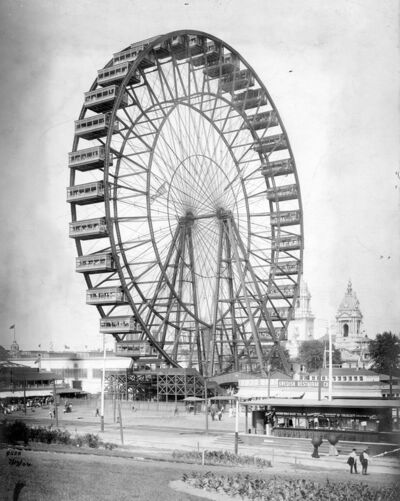 | |
| Alternative names | Observation Wheel |
|---|---|
| Location | The Trail |
| No. of Buildings | 1 |
| Owner | Chicago House Wrecking Company |
| Construction | |
| Construction Cost | $380,000 ($11.5 million in 2021) |
| Proft | $267,000 ($8.05 million in 2021) |
| Entry | |
| Adult Entry | 50¢ ($15 in 2021) |
| Architecture | |
| Architect | George Washington Gale Ferris Jr. |
Located on The Trail, the Ferris Wheel, built by George Washington Gale Ferris Jr. was a symbol of the Fair.
Before the Fair
George Ferris
Born in Galesburg, Illinois in 1859, Ferris attended Rensselaer Polytechnical Institute in New York, where he graduated in 1881 with a degree in engineering.
Ferris claimed that he developed he concept for the Ferris wheel while at a dinner in Chicago.
Ferris' one-of-a-kind design was able to carry five times the 1,200 ton capacity limit. In 80 miles an hour winds, the sway of the colossal wheel was less than half an inch.
Ferris thought the 1893 fair management had robbed him and his investors of his cut in the $726,805 ($21.9 million in 2021) profit that his wheel had brought in.
Constantly in litigation, Ferris continued to create smaller wheels, selling them mostly to amusement parks across the U.S., but he made little profit. Ferris desired to build and sell bigger and better wheels, but demand was sporadic.
After his wife left him in 1896, Ferris suffered from depression. He died alone on Nov. 21, 1896, bankrupt at the age of 37, in Pittsburgh's Mercy Hospital. Ferris never saw his masterpiece creation rise again in St. Louis.
Ferris never sought or received a patent for his marvelous wheel-invention. George Ferris Jr.'s design for the observation wheel was copied by owners of resorts (such as Coney Island).
Chicago's World Fair
Modeled on a bicycle wheel, Pennsylvania bridgebuilder George Washington Gale Ferris Jr., an engaging and social visionary, created the mammoth structure in Pittsburgh (but sections were made at nine steel mills in Detroit, and in Cleveland and Youngstown Ohio, Pittsburgh and Bethlehem, Pennsylvania).
Three people died building the great Observation Wheel.
Chicago Park
In mid-1894, the great wheel was sold at a bankruptcy auction in Chicago for $8,150. Rather that being scrapped, the Ferris Wheel was shipped to St. Louis and reassembled for the Louisiana Purchase Exposition.
Description
The observation wheel was 264 feet high. Two steel forks held up a 70-ton, 46 1/2' axle.
Two steam engines, arranged in a dual reversing engine provided 2,000hp to rotate the 4,200 ton wheel. The power was applied through a series of cogs to a sprocket chain which engages wide cogs on the outside of each rim. An oversized air brake was used for stopping.
The wheel could accommodate 2,160 passengers at a time. 36 cars were attached to the wheel. The cars were made of steel, clad in wood. Each car held a security attendant, and could hold 60 standing passengers, or 40 passengers sitting on swivel chairs.
St. Louis
178 freight cars brought the huge attraction the St. Louis at a cost of $150,000 ($4.52 million in 2021). However, the wheel recouped its relocation coats in only four months of operation.
Operating the Ferris Wheel required 44 persons, including guards, platform guides, an engineer and a fireman. The boiler required four tons of coal for each day’s operations. Three million people were carried without injury. The wheel carried approximately 7.5 percent of the paid admissions to the Fair each day.
On July 12 1904, Maud Nicholson, a dare-devil made one entire revolution of the huge Observation Wheel standing on top of one of the cars.
Erection
The Ferris Wheel was erected at the very center of the fair, near but not in The Pike.
-
Scaffolding Erected
-
Bases Erected
-
Support Posts
-
Axle Ready to be placed
-
Axle in place
-
Outer Rim Start
-
Outer Rim Continues
-
Outer Rim
-
Outer Rim
-
Outer Rim
-
Outer Rim
-
Outer Rim
-
Initial cars placed
Weddings
Individual cars could be rented out for weddings and other special engagements. There were 50 marriage ceremonies on the great wheel, in fact it became so popular (one couple was married on horseback in one of the car, while another pairing was married on top of one of the cars), that a special car, complete with a piano was designated for the Observation Wheel ceremonies.
After The Fair
The Chicago House Wrecking Company attempted to sell the Ferris Wheel to the operators of Coney Island amusement park in New York.
The estimated costs of taking down and re-erecting the wheel there would have been approximately $166,500 ($5.02 million in 2021), while the salvage value, if the wheel were wrecked, was approximately $75,950 ($2.29 million in 2021).
After Coney Island declined to purchase the wheel, it was deemed too expensive to ship (and to store); it was decided that on May 11th, 1906, Ferris' masterpiece would be toppled and sold for scrap. Their profit was $1,800 ($54,287 in 2021)dollars.
100 pounds of dynamite collapsed the wheel into a 90 foot-wide mass of wreckage.
The Axle
There has been an insatiable curiosity about the Wheel's axle. One long-standing rumor that the axle was it buried buried near Skinker Avenue in Forest Park.
A few scholars have tireless studied official documents that have put a stronger light on the axle's fate.
The giant axle of the wheel was returned to the yards of the Chicago House Wrecking Company, where it remained until it was cut up for its steel content at the beginning of World War I.
